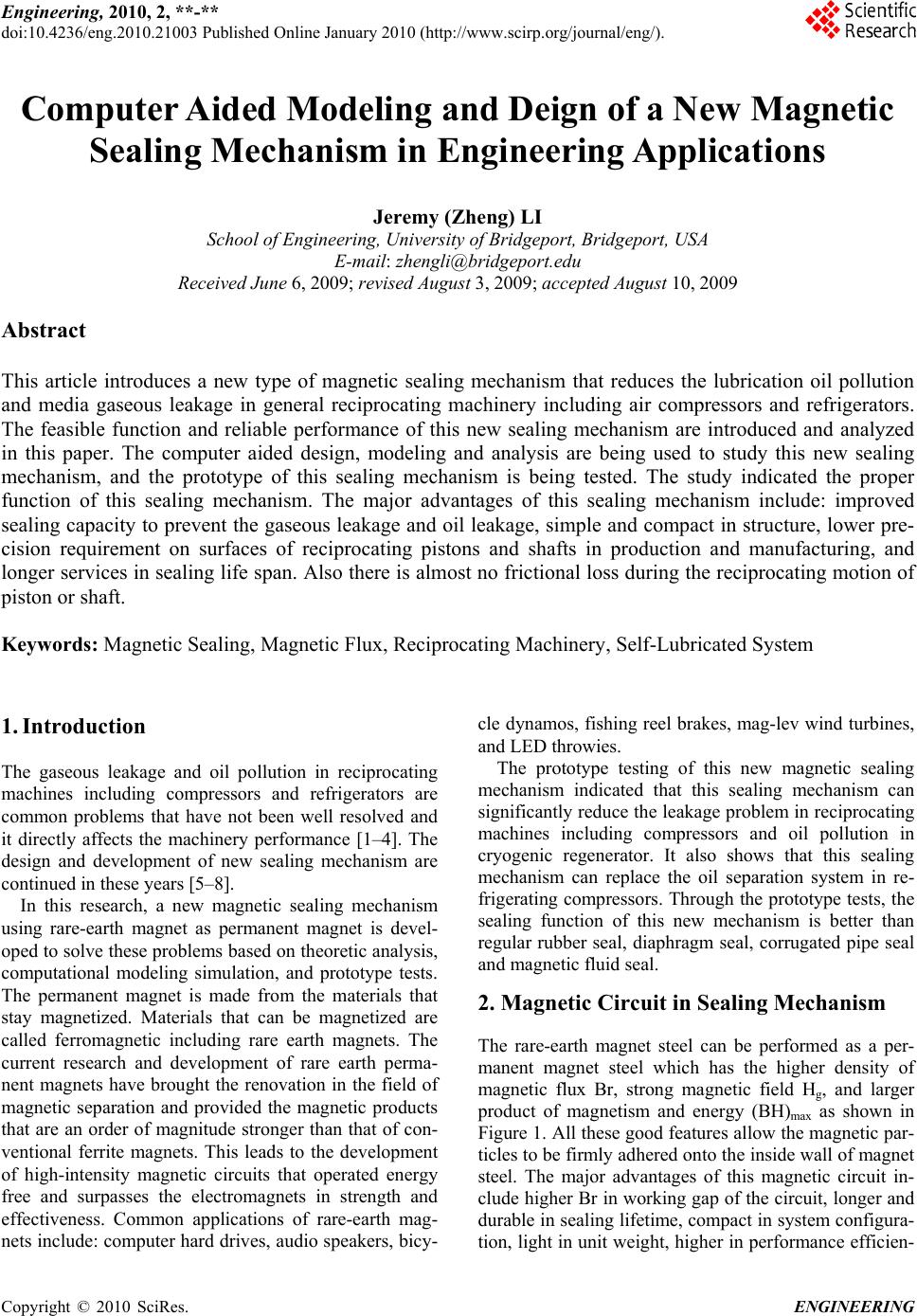
Engineering, 2010, 2, **-**
doi:10.4236/eng.2010.21003 Published Online January 2010 (http://www.scirp.org/journal/eng/).
Copyright © 2010 SciRes. ENGINEERING
Computer Aided Modeling and Deign of a New Magnetic
Sealing Mechanism in Engineering Applications
Jeremy (Zheng) LI
School of Engineering, University of Bridgeport, Bridgeport, USA
E-mail: zhengli@bridgeport.edu
Received June 6, 2009; revised August 3, 2009; accepted August 10, 2009
Abstract
This article introduces a new type of magnetic sealing mechanism that reduces the lubrication oil pollution
and media gaseous leakage in general reciprocating machinery including air compressors and refrigerators.
The feasible function and reliable performance of this new sealing mechanism are introduced and analyzed
in this paper. The computer aided design, modeling and analysis are being used to study this new sealing
mechanism, and the prototype of this sealing mechanism is being tested. The study indicated the proper
function of this sealing mechanism. The major advantages of this sealing mechanism include: improved
sealing capacity to prevent the gaseous leakage and oil leakage, simple and compact in structure, lower pre-
cision requirement on surfaces of reciprocating pistons and shafts in production and manufacturing, and
longer services in sealing life span. Also there is almost no frictional loss during the reciprocating motion of
piston or shaft.
Keywords: Magnetic Sealing, Magnetic Flux, Reciprocating Machinery, Self-Lubricated System
1. Introduction
The gaseous leakage and oil pollution in reciprocating
machines including compressors and refrigerators are
common problems that have not been well resolved and
it directly affects the machinery performance [1–4]. The
design and development of new sealing mechanism are
continued in these years [5–8].
In this research, a new magnetic sealing mechanism
using rare-earth magnet as permanent magnet is devel-
oped to solve these problems based on theoretic analysis,
computational modeling simulation, and prototype tests.
The permanent magnet is made from the materials that
stay magnetized. Materials that can be magnetized are
called ferromagnetic including rare earth magnets. The
current research and development of rare earth perma-
nent magnets have brought the renovation in the field of
magnetic separation and provided the magnetic products
that are an order of magnitude stronger than that of con-
ventional ferrite magnets. This leads to the development
of high-intensity magnetic circuits that operated energy
free and surpasses the electromagnets in strength and
effectiveness. Common applications of rare-earth mag-
nets include: computer hard drives, audio speakers, bicy-
cle dynamos, fishing reel brakes, mag-lev wind turbines,
and LED throwies.
The prototype testing of this new magnetic sealing
mechanism indicated that this sealing mechanism can
significantly reduce the leakage problem in reciprocating
machines including compressors and oil pollution in
cryogenic regenerator. It also shows that this sealing
mechanism can replace the oil separation system in re-
frigerating compressors. Through the prototype tests, the
sealing function of this new mechanism is better than
regular rubber seal, diaphragm seal, corrugated pipe seal
and magnetic fluid seal.
2. Magnetic Circuit in Sealing Mechanism
The rare-earth magnet steel can be performed as a per-
manent magnet steel which has the higher density of
magnetic flux Br, strong magnetic field Hg, and larger
product of magnetism and energy (BH)max as shown in
Figure 1. All these good features allow the magnetic par-
ticles to be firmly adhered onto the inside wall of magnet
steel. The major advantages of this magnetic circuit in-
clude higher Br in working gap of the circuit, longer and
durable in sealing lifetime, compact in system configura-
tion, light in unit weight, higher in performance efficien-